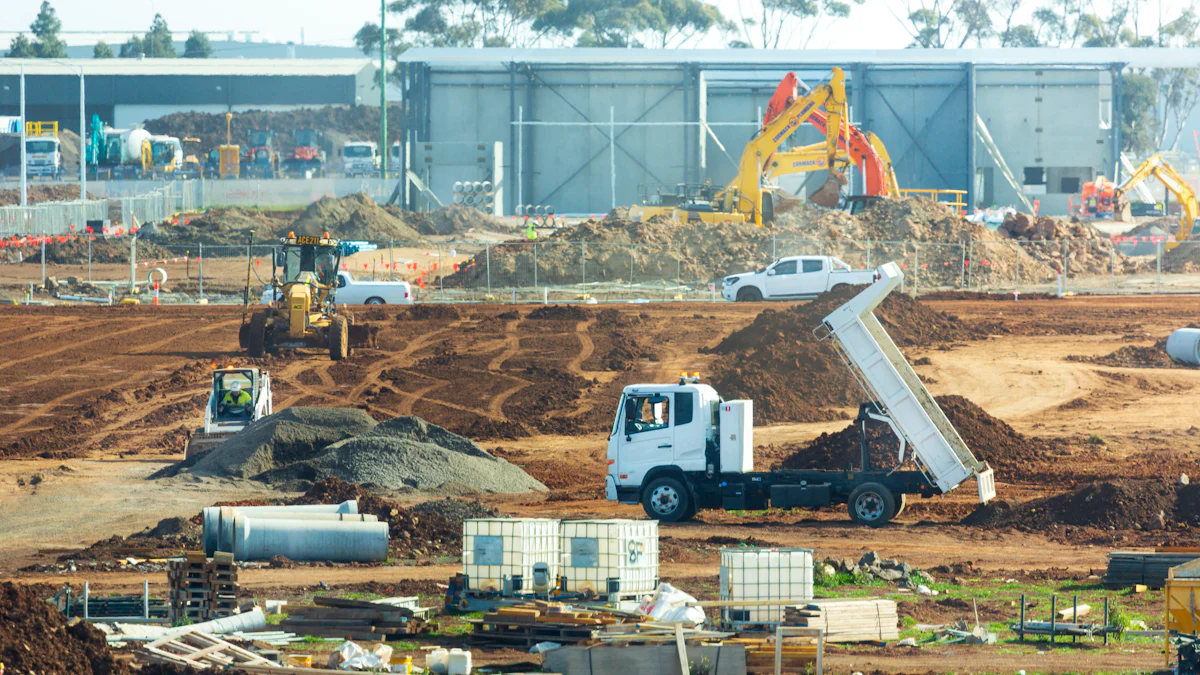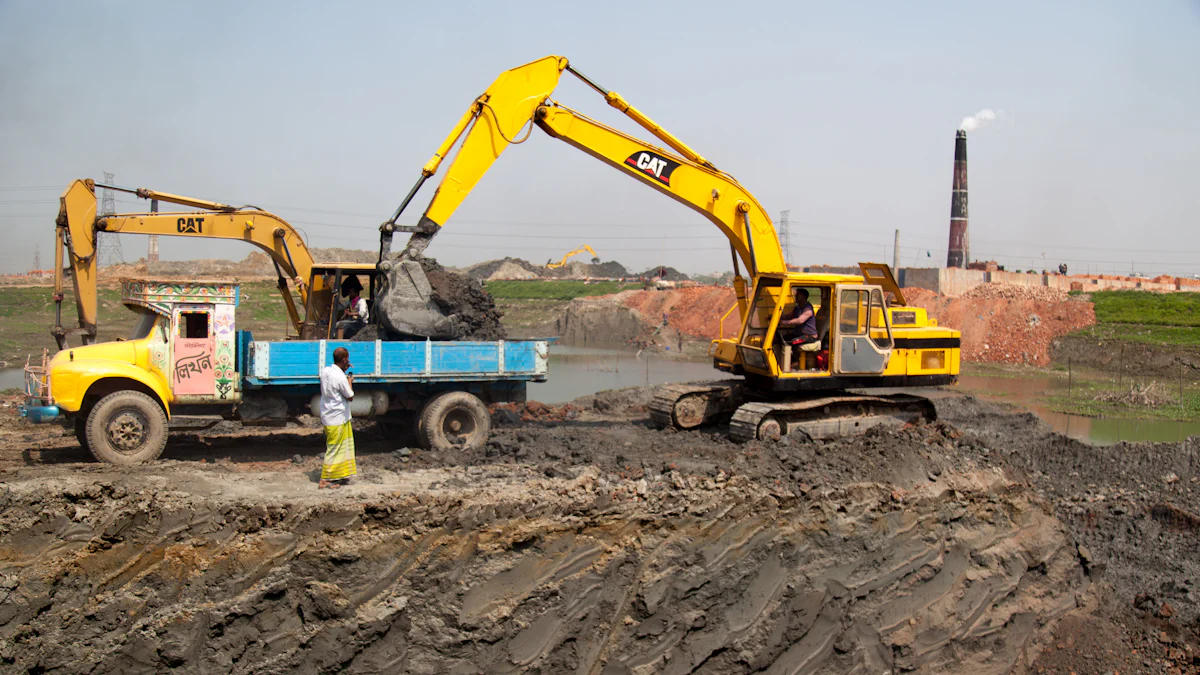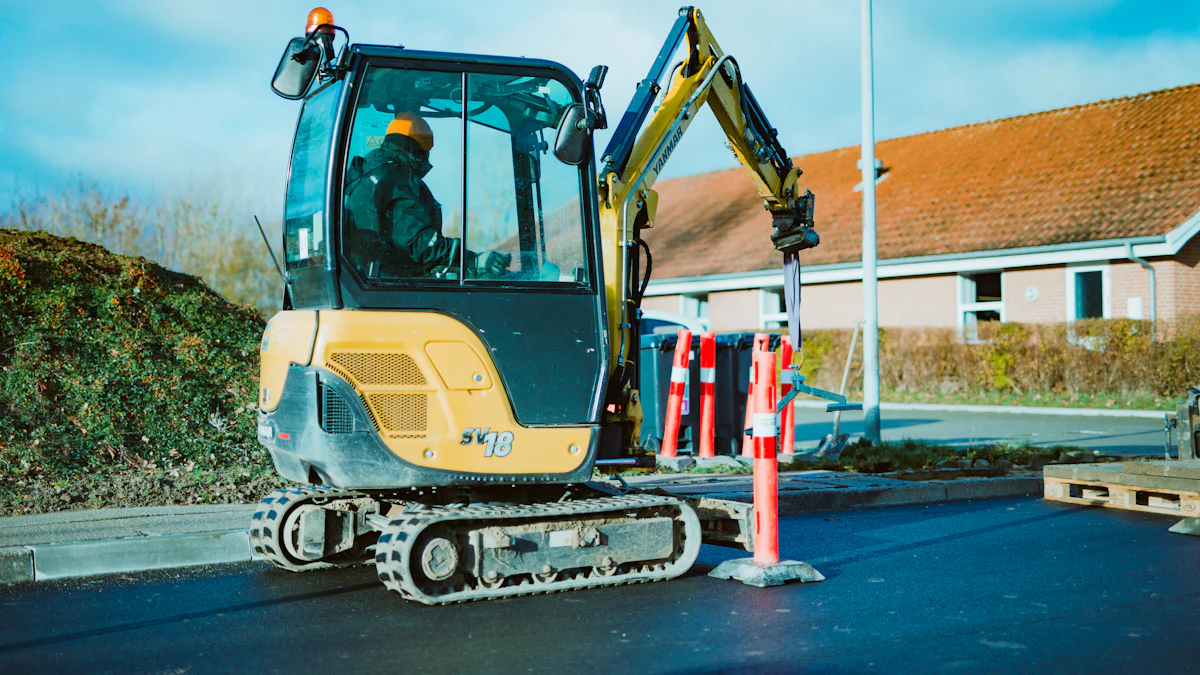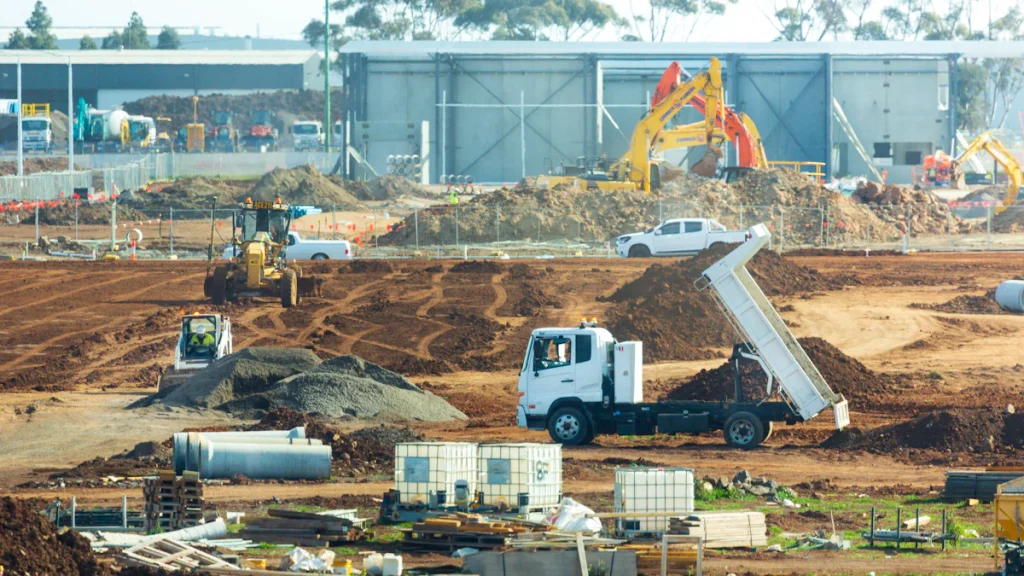
Maintaining your excavator jock hammer is essential for ensuring its efficiency and durability. Regular charging and maintenance prevent wear and tear, keeping the equipment in peak condition. Neglecting these tasks can lead to reduced performance and costly repairs. Proper care also enhances safety during operation, minimizing risks caused by malfunctioning components. Trusted suppliers like YNF Machinery provide high-quality parts that simplify maintenance. Their reliable products ensure your equipment operates smoothly, reducing downtime and extending its lifespan. By prioritizing upkeep, you protect your investment and maintain optimal performance.
Key Takeaways
Regular maintenance and charging of your hydraulic breaker are crucial for optimal performance and longevity.
Neglecting maintenance can lead to costly repairs, reduced efficiency, and safety hazards on the job site.
Always follow the manufacturer’s guidelines for charging and maintenance to ensure proper procedures are followed.
Routine cleaning and lubrication of the breaker prevent wear and tear, enhancing its reliability and performance.
Using high-quality parts from trusted suppliers like YNF Machinery simplifies maintenance and extends the lifespan of your equipment.
Create a maintenance schedule to regularly inspect and care for your hydraulic breaker, ensuring it operates at peak efficiency.
Address common issues promptly, such as pressure problems or excessive noise, to maintain safety and productivity.
Why Regular Maintenance and Charging a Hydraulic Breaker Are Crucial
Proper care of your hydraulic breaker is essential for maintaining its performance and longevity. Neglecting regular maintenance or skipping the correct steps for charging a hydraulic breaker can lead to reduced efficiency, costly repairs, and even safety hazards. Understanding the importance of these practices ensures that your equipment operates at its best.
The Impact of Hydraulic Breakers on Excavator Performance
Hydraulic breakers play a vital role in transforming excavators into powerful demolition tools. They allow you to break through concrete, asphalt, and rock with precision and efficiency. This capability is crucial for contractors working under tight deadlines. A well-maintained hydraulic breaker ensures consistent performance, helping you complete projects on time and within budget.
“Hydraulic breakers turn compact loaders and excavators into powerful demolition machines, breaking concrete, asphalt, rock, and other materials.” – ConstructionEquipment.com
When your breaker operates efficiently, it reduces the strain on your excavator’s hydraulic system. This not only extends the life of the breaker but also protects the excavator from unnecessary wear and tear. Regular charging and maintenance ensure that the breaker delivers optimal power and precision, enhancing the overall performance of your equipment.
Risks of Skipping Maintenance
Failing to perform regular maintenance or neglecting the proper steps for charging a hydraulic breaker can lead to several issues. A low nitrogen charge, for instance, weakens the breaker’s impact, reducing its effectiveness. Over time, this can cause delays in your projects and increase operational costs.
Skipping maintenance also exposes critical components to damage. Without proper lubrication, metal-to-metal contact occurs, accelerating wear and tear. Dirt and debris can clog the hydraulic system, leading to blockages and leaks. These problems not only compromise the breaker’s performance but also increase the risk of sudden breakdowns.
“Lubrication prevents bushing and metal-to-metal contact, reducing the chances of wear and tear arising as quickly.” – RawPlant.co.uk
Ignoring maintenance can also result in safety hazards. A malfunctioning breaker may produce excessive noise or vibration, which can harm operators and nearby workers. Regular inspections and proper charging prevent these risks, ensuring a safer work environment.
Advantages of Following Proper Steps for Charging and Maintenance
Adhering to the correct procedures for charging a hydraulic breaker offers numerous benefits. It ensures that the breaker operates at its full potential, delivering consistent and powerful impacts. This improves productivity, allowing you to complete tasks more efficiently.
Proper charging also extends the lifespan of the breaker. By maintaining the correct nitrogen pressure and inspecting hydraulic connections, you prevent premature wear and costly repairs. Regular maintenance keeps the breaker in top condition, reducing downtime and maximizing your return on investment.
“A savvy operator and a comprehensive maintenance plan go a long way when it comes to maximizing the life of a rig-mounted hydraulic breaker.” – CompactEquip.com
Additionally, following the manufacturer’s guidelines for charging and maintenance enhances safety. Secure hydraulic connections and clean components minimize the risk of accidents. By taking these steps, you protect both your equipment and your team.
Proper Steps for Charging a Hydraulic Breaker

Properly charging a hydraulic breaker ensures its efficiency and extends its lifespan. Following the correct steps minimizes risks and keeps your equipment in top condition. Here’s how you can prepare and execute the process effectively.
Preparing for the Charging Process
Reviewing the Manufacturer’s Specifications
Before you begin, always refer to the manufacturer’s guidelines. These instructions provide critical details about the breaker’s requirements, including the recommended nitrogen pressure levels and compatible tools. Skipping this step can lead to improper charging, which may affect the breaker’s performance. Keep the manual handy to ensure you follow the correct procedures.
Cleaning the Breaker to Remove Debris
Dirt and debris can interfere with the charging process. Before proceeding, inspect the breaker and clean it thoroughly. Use a soft brush or cloth to remove any buildup around the charging port. This step prevents contaminants from entering the system, ensuring smooth operation and protecting the hydraulic components.
Checking and Adjusting Nitrogen Pressure
Tools Required for Pressure Adjustment
To adjust the nitrogen pressure, you’ll need a pressure gauge, a nitrogen charging kit, and a wrench. These tools help you monitor and regulate the pressure accurately. Ensure that all equipment is in good condition before starting the process.
Safe Steps to Check and Adjust Pressure
Disconnect the breaker from the power source to avoid accidents.
Locate the nitrogen charging port on the breaker.
Attach the charging hose securely to the port and connect it to the nitrogen pump.
Check the pressure gauge to determine the current nitrogen level.
Adjust the pressure as needed, following the manufacturer’s specifications.
Once the desired pressure is reached, disconnect the hose and seal the port.
Monitoring the pressure gauge during this process is crucial. Overcharging or undercharging can compromise the breaker’s performance. Always aim for the recommended pressure range to achieve optimal performance.
Inspecting Hydraulic Connections and Fluid Levels
Ensuring Secure Hose Connections
Loose or damaged hydraulic connections can lead to leaks and reduced efficiency. Inspect the breaker’s hoses and fittings for signs of wear or looseness. Tighten any loose connections and replace damaged components immediately. Secure connections ensure that the hydraulic system operates without interruptions.
Verifying Hydraulic Fluid Levels and Quality
Check the hydraulic fluid level in the excavator’s reservoir. Low fluid levels can cause the breaker to underperform, while contaminated fluid can damage internal components. Use a dipstick or sight glass to verify the level and inspect the fluid’s color and consistency. Replace the fluid if it appears dirty or degraded. Maintaining proper hydraulic fluid levels is essential for smooth operation and long-term reliability.
By following these proper steps for charging a hydraulic breaker, you ensure that your equipment remains efficient and reliable. Regular inspections and adherence to guidelines protect your investment and keep your projects on track.
Maintenance Tips to Keep Your Hydraulic Breaker in Top Condition
Proper maintenance is essential to ensure your hydraulic breaker operates efficiently and lasts longer. By following these tips, you can keep your equipment in excellent condition and avoid unnecessary downtime.
Cleaning the Breaker After Use
Removing Dirt and Debris Effectively
After every use, clean your breaker thoroughly to remove dirt and debris. Use a soft brush or cloth to wipe down the surface and focus on areas where debris tends to accumulate, such as around the tool and bushings. This routine maintenance step prevents contaminants from entering the hydraulic system, which could compromise performance. Keeping the breaker clean also reduces wear on critical components.
“Hydraulic breakers require regular cleaning to maintain their efficiency and prevent damage caused by debris.”
Inspecting for Visible Damage During Cleaning
While cleaning, perform a visual inspection of the breaker. Look for cracks, dents, or other signs of damage on the tool, bushings, and housing. Identifying these issues early allows you to address them before they escalate into costly repairs. Regular visual inspections during cleaning ensure that your breaker remains safe and reliable for operation.
Lubricating the Breaker for Optimal Performance
Importance of Regular Lubrication
Lubrication plays a vital role in maintaining your breaker’s performance. Apply high-quality grease to the tool and bushings every two to four hours of operation. This prevents metal-to-metal contact, reducing wear and tear. Manufacturers recommend using high-moly grease, which bonds effectively to the steel and provides persistent lubrication even under extreme conditions.
“Hydraulic breakers need lots of high-quality grease to ensure smooth operation and prevent premature wear.”
Recommended Lubrication Intervals
Follow the manufacturer’s guidelines for lubrication intervals. Operating conditions, such as temperature and workload, may affect how often you need to apply grease. For heavy-duty tasks, increase the frequency of lubrication to maintain optimal performance. Consistent lubrication not only enhances efficiency but also extends the lifespan of your breaker.
Inspecting for Wear and Tear
Checking Critical Components Like Chisels and Bushings
Regular inspection of critical components is crucial for maintaining your breaker. Examine the chisels and bushings for signs of wear, such as thinning or uneven surfaces. Replace worn parts promptly to prevent further damage to the breaker. Routine maintenance ensures that these components function correctly, preserving the overall integrity of the equipment.
Identifying Cracks or Other Signs of Damage
Inspect the breaker’s housing and internal parts for cracks or other structural issues. Pay close attention to areas that experience high stress during operation. Addressing these problems early prevents them from worsening and causing operational failures. Regular inspections safeguard your breaker’s performance and reliability.
By incorporating these maintenance practices into your routine, you can keep your hydraulic breaker in top condition. Cleaning, lubrication, and inspection are simple yet effective steps that protect your investment and ensure consistent performance. Prioritize these tasks to maximize the efficiency and longevity of your equipment.
Common Mistakes to Avoid When Charging and Maintaining a Hydraulic Breaker
Proper care of your hydraulic breaker ensures its efficiency and longevity. However, certain mistakes during charging and maintenance can lead to reduced performance or even damage. Avoiding these common errors will help you keep your equipment in top condition.
Overcharging or Undercharging the Breaker
Maintaining the correct nitrogen pressure is crucial for optimal breaker performance. Overcharging the breaker can cause excessive force during operation, leading to internal damage. On the other hand, undercharging results in weak impacts, reducing the tool’s effectiveness. Both scenarios can shorten the lifespan of your breaker and increase repair costs.
To avoid these issues, always use a pressure gauge to monitor nitrogen levels. Follow the manufacturer’s specifications for the recommended pressure range. Regularly checking and adjusting the pressure ensures that your breaker operates at its full potential without unnecessary strain.
“A low nitrogen charge can lead to weak hits and performance issues, while overcharging may damage internal components.”
Using Incorrect Tools or Fluids
Using the wrong tools or fluids during maintenance can severely impact your breaker’s performance. For instance, improper tools may fail to secure connections properly, leading to leaks or inefficiencies. Similarly, using incompatible hydraulic fluids can damage internal components and reduce the equipment’s lifespan.
Always rely on specialized tools designed for your breaker model. These tools ensure precise adjustments and secure fittings. Additionally, use high-quality hydraulic fluids recommended by the manufacturer. Proper utilization of maintenance tools and fluids not only enhances efficiency but also protects your investment.
“Using the right maintenance tools can help increase the lifespan of the hydraulic breaker, while incorrect tools or unprofessional use can shorten its lifespan.”
Ignoring Manufacturer Guidelines
Manufacturer guidelines provide essential instructions for charging and maintaining your breaker. Ignoring these recommendations can result in improper procedures, leading to reduced efficiency or equipment failure. For example, skipping lubrication intervals or neglecting cleaning routines can accelerate wear and tear.
Keep the user manual accessible and refer to it regularly. Follow the specified steps for charging, lubrication, and inspections. Adhering to these guidelines ensures that your breaker remains reliable and performs consistently.
By avoiding these common mistakes, you can maximize the efficiency and durability of your hydraulic breaker. Proper charging, the use of correct tools, and adherence to manufacturer guidelines are simple yet effective practices that protect your equipment and ensure smooth operation.
Operating Without Regular Maintenance
Neglecting regular maintenance for your hydraulic breaker can lead to significant problems. Without consistent care, the equipment’s performance declines, and its lifespan shortens. You risk facing unexpected breakdowns, costly repairs, and reduced efficiency on the job site.
Increased Wear and Tear
When you skip maintenance, critical components like chisels, bushings, and seals wear out faster. Dirt and debris accumulate, causing abrasive damage to internal parts. Without proper lubrication, metal surfaces grind against each other, accelerating deterioration. This neglect not only affects the breaker but also puts additional strain on your excavator’s hydraulic system.
“Lubrication prevents bushing and metal-to-metal contact, reducing the chances of wear and tear arising as quickly.”
Reduced Efficiency and Productivity
A poorly maintained breaker struggles to deliver consistent power. Low nitrogen pressure or clogged hydraulic connections weaken its impact force. This inefficiency slows down your work, increasing project timelines and operational costs. Regular maintenance ensures that your breaker performs at its best, helping you complete tasks on schedule.
Safety Hazards
Operating a hydraulic breaker without regular maintenance poses safety risks. Loose connections, worn-out parts, or contaminated hydraulic fluid can lead to sudden malfunctions. Excessive noise or vibration from neglected equipment endangers operators and nearby workers. Routine inspections and upkeep minimize these risks, creating a safer work environment.
Financial Consequences
Ignoring maintenance often results in expensive repairs or the need for premature replacement. For example, using incorrect tools or neglecting specialized maintenance procedures can damage the breaker. Proper utilization of maintenance tools, as recommended by the manufacturer, protects your investment and reduces long-term costs.
“Using the right maintenance tools can help increase the lifespan of the hydraulic breaker, while incorrect tools or unprofessional use can shorten its lifespan and lead to the need for replacement.”
Simple Steps to Avoid Neglect
Create a Maintenance Schedule: Set reminders for cleaning, lubrication, and inspections.
Use the Right Tools: Invest in specialized tools designed for your breaker model.
Follow Manufacturer Guidelines: Refer to the manual for proper procedures and intervals.
Inspect After Every Use: Check for visible damage and address issues immediately.
By prioritizing regular maintenance, you ensure that your hydraulic breaker remains efficient, safe, and reliable. Taking these steps protects your equipment, enhances productivity, and saves you money in the long run.
How YNF Machinery Supports Hydraulic Breaker Maintenance
Maintaining your excavator jock hammer requires access to reliable parts and expert support. YNF Machinery stands out as a trusted partner in ensuring your equipment remains in top condition. With a commitment to quality and customer satisfaction, YNF Machinery provides everything you need to keep your hydraulic breaker operating efficiently.
High-Quality Parts for Excavator Jock Hammers
Overview of YNF Machinery’s Product Range
YNF Machinery offers an extensive selection of parts designed specifically for excavator jock hammers. These components meet the highest standards of durability and performance, ensuring compatibility with various models and brands. Whether you need replacement chisels, bushings, or seals, YNF Machinery has you covered.
The company’s product range includes essential items like hydraulic seals, hoses, and nitrogen charging kits. These parts play a critical role in maintaining the hydraulic power source of your breaker. By sourcing these components from YNF Machinery, you ensure that your equipment operates at peak efficiency.
“High-quality parts are essential for maintaining the performance and longevity of hydraulic breakers.” – Industry Experts
YNF Machinery’s rigorous quality inspections guarantee that every product meets strict performance criteria. This attention to detail ensures that your excavator jock hammer remains reliable, reducing the risk of unexpected breakdowns. With YNF Machinery, you gain access to parts that enhance the durability and functionality of your equipment.
Reliable Support for Maintenance Needs
Benefits of Sourcing from YNF Machinery
When it comes to maintaining your hydraulic power source, YNF Machinery provides more than just parts. The company offers comprehensive support to help you address maintenance challenges effectively. Their team of experts is available to guide you in selecting the right components for your excavator jock hammer.
One of the key benefits of sourcing from YNF Machinery is their competitive pricing. You receive high-quality parts without exceeding your budget, making it easier to maintain your equipment regularly. Additionally, the company’s low minimum order quantities allow you to stock up on essential items without overcommitting resources.
“Routine maintenance reduces operating costs and increases profitability.” – Logical Reasoning
YNF Machinery also simplifies the logistics of acquiring parts. Their user-friendly platform ensures a seamless ordering process, while their efficient shipping services minimize downtime. By partnering with YNF Machinery, you save time and resources, enabling you to focus on your projects.
The company’s dedication to customer satisfaction sets it apart. YNF Machinery prioritizes your needs, ensuring that you have access to the tools and components required to maintain your hydraulic power source. This commitment to excellence makes them a reliable ally in keeping your excavator jock hammer in optimal condition.
Troubleshooting Common Hydraulic Breaker Issues

Hydraulic breakers are essential tools for heavy-duty tasks, but they can encounter issues that disrupt their performance. Identifying and resolving these problems promptly ensures your equipment operates efficiently and safely. Below are common issues you may face and practical steps to address them.
Breaker Not Operating Properly
A hydraulic breaker that fails to function correctly can delay your projects and increase costs. Understanding the root cause helps you resolve the issue effectively.
Diagnosing Pressure-Related Problems
Pressure-related problems often cause a hydraulic breaker to underperform. Low nitrogen pressure weakens the impact force, while excessive pressure can damage internal components. To address this, you should monitor the pressure gauge regularly. This tool allows you to check if the nitrogen levels fall within the manufacturer’s recommended range. Adjust the pressure as needed to restore the breaker’s efficiency.
“A low nitrogen charge can lead to weak hits and performance issues, while overcharging may damage internal components.” – Industry Experts
If the breaker still struggles after adjusting the pressure, inspect the hydraulic system for other potential issues. Faulty seals or hoses may cause pressure loss, affecting the breaker’s performance. Replacing worn or damaged components ensures the hydraulic system operates smoothly.
Checking for Blockages or Leaks
Blockages or leaks in the hydraulic system can also hinder the breaker’s operation. Dirt and debris often clog the hydraulic lines, restricting fluid flow. Inspect the hoses and connections for visible obstructions. Clean the affected areas thoroughly to restore proper fluid circulation.
Leaks are another common issue. Examine the hydraulic hoses and fittings for signs of wear or damage. Replace any worn or damaged components immediately to prevent further complications. Regular inspections help you identify and address these problems before they escalate.
Excessive Noise or Vibration
Excessive noise or vibration during operation indicates underlying issues with your hydraulic breaker. Addressing these problems promptly protects both the equipment and the operator.
Identifying and Fixing Loose Components
Loose components often cause unusual noise or vibration. Inspect the breaker’s bolts, nuts, and fittings to ensure they are secure. Tighten any loose parts to stabilize the equipment. Pay special attention to the tool and bushings, as these areas experience significant stress during operation.
“Loose connections or components can lead to excessive noise and vibration, compromising the breaker’s performance.” – Maintenance Experts
If tightening the components does not resolve the issue, consider replacing worn or damaged components. For example, degraded bushings may fail to absorb vibrations effectively, leading to increased noise levels. Replacing these parts restores the breaker’s stability and reduces operational noise.
Addressing Wear on Internal Parts
Internal wear is another common cause of excessive noise or vibration. Over time, the hydraulic breaker’s internal components, such as pistons and seals, may degrade due to constant use. Inspect these parts for signs of wear or damage. Replacing worn or damaged components ensures the breaker operates smoothly and quietly.
Regular lubrication also plays a crucial role in minimizing noise and vibration. Apply high-quality grease to the tool and bushings to reduce friction and enhance performance. Following the manufacturer’s guidelines for lubrication intervals helps you maintain the breaker’s efficiency.
By addressing these common issues, you can keep your hydraulic breaker in top condition. Regular inspections, proper maintenance, and timely repairs ensure your equipment performs reliably, reducing downtime and extending its lifespan.
Regular maintenance and charging a hydraulic breaker are essential for keeping your equipment efficient and reliable. By following the correct steps, you ensure the system operates smoothly, reducing wear and tear on critical components. Avoiding common mistakes, such as improper fluid checks or neglecting the system’s pressure levels, protects your investment and enhances safety. Trusted suppliers like YNF Machinery provide high-quality parts and expert support, making maintenance easier and more effective. Prioritize proper care to extend the lifespan of your hydraulic breaker and maintain peak performance on every project.





